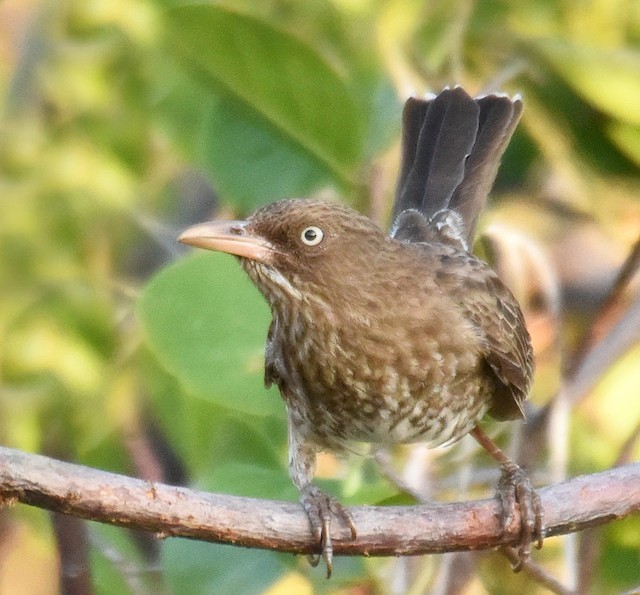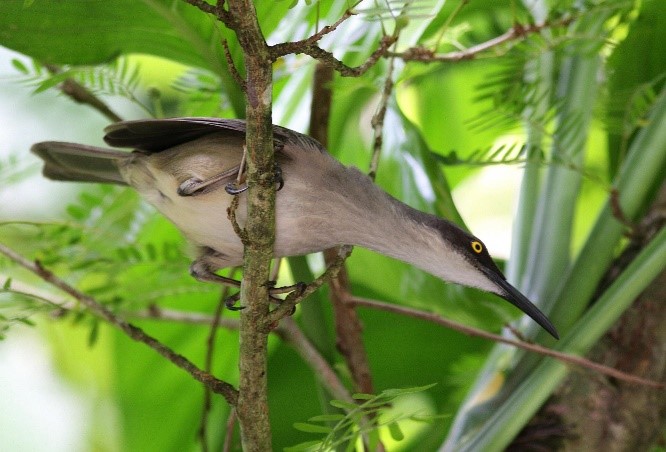Mimidae: Thrashers

Pearly-eyed Thrasher. © Steven Mlodinow
Thrashers are sturdy, long-tailed songbirds of the New World that generally resemble thrushes and are analogous in several ways to several of the Old World laughingthrushes (a.k.a. “babblers” of the Leiothrichidae). Despite these apparent affinities, genetic analyses indicate that thrashers are most closely related to another Old World family, the starlings (Sturnidae).
The family name Mimidae refers to the exceptional capacity of many thrashers to mimic the vocalizations of other birds, also evoked in the alternative name “mimic-thrushes.” The most familiar example is the Northern Mockingbird (Mimus polyglottos), whose English and scientific names further attest to its accomplished mimicry, and several other thrasher species are similarly capable.

Gray Trembler. © Guy Poisson
The Mimidae apparently originated in Middle America, where they reach their peak diversity in arid regions of Mexico and the southwestern U.S., and in the Lesser Antilles. A surprisingly small number of species occur elsewhere. Most mimids inhabit dry scrub, brush, and other semiopen habitats, where some family members are among the most vocal and conspicuous birds.
Taxonomy
The species-level taxonomy of the Mimidae is fairly well established, though a few doubts remain about the appropriate treatment of certain isolated forms that appear to be in the early or middle stages of speciation. Among the most complicated cases is that of the Lesser Antillean tremblers, traditionally considered a single species, now regarded as two species that each show significant internal variation. As currently understood, the family comprises approximately 35 to 38 species.
Blue Mockingbird (Melanotis caerulescens)
Blue-and-white Mockingbird (Melanotis hypoleucus)
Black Catbird (Melanoptila glabrirostris)
Gray Catbird (Dumetella carolinensis)
White-breasted Thrasher (Ramphocinclus brachyurus)
“Martinique Thrasher” (R. b. brachyurus)
“St. Lucia Thrasher” (R. b. sanctaeluciae)
Scaly-breasted Thrasher (Allenia fusca)
Pearly-eyed Thrasher (Margarops fuscatus)
Brown Trembler (Cinclocerthia ruficauda)
Gray Trembler (Cinclocerthia gutturalis)
Curve-billed Thrasher (Toxostoma curvirostre)
“Western Curve-billed Thrasher” (T. c. palmeri)
“Eastern Curve-billed Thrasher” (T. c. curvirostre)
Ocellated Thrasher (Toxostoma ocellatum)
Brown Thrasher (Toxostoma rufum)
Long-billed Thrasher (Toxostoma longirostre)
Cozumel Thrasher (Toxostoma guttatum)
Bendire’s Thrasher (Toxostoma bendirei)
Gray Thrasher (Toxostoma cinereum)
California Thrasher (Toxostoma redivivum)
Crissal Thrasher (Toxostoma crissale)
Le Conte’s Thrasher (Toxostoma lecontei)
Vizcaino Thrasher (Toxostoma arenicola)
Sage Thrasher (Oreoscoptes montanus)
Chilean Mockingbird (Mimus thenca)
Patagonian Mockingbird (Mimus patagonicus)
Chalk-browed Mockingbird (Mimus saturninus)
White-banded Mockingbird (Mimus triurus)
Brown-backed Mockingbird (Mimus dorsalis)
Long-tailed Mockingbird (Mimus longicaudatus)
Socorro Mockingbird (Mimus graysoni)
Northern Mockingbird (Mimus polyglottos)
Tropical Mockingbird (Mimus gilvus)
“Tropical Mockingbird” (M. g. gilvus)
“San Andrés Mockingbird” (M. g. magnirostris)
Bahama Mockingbird (Mimus gundlachii)
Galápagos Mockingbird (Mimus parvulus)
Floreana Mockingbird (Mimus trifasciatus)
San Cristóbal Mockingbird (Mimus melanotis)
Española Mockingbird (Mimus macdonaldi)
References
Boyd, J.H., 2016. Taxonomy in Flux: Muscicapoidea I: Buphagidae through Sturnidae. http://jboyd.net/Taxo/List25.html#mimidae. (Posted May 2, 2016; Accessed December 23, 2021.)
Brewer, D., and B.K. MacKay. 2001. Wrens, Dippers, and Thrashers. Yale University Press. New Haven.
Miller, M., J. DaCosta, J. Mortensen, M. Sorenson, R. Curry, and M. Reed. 2019. Next-generation phylogeny of Caribbean Thrashers. http://mj-miller.net/projects/post/thrashers. (Accessed November 24, 2019.)
Roberson, D. 2000. Bird Families of the World: Thrashers and Mimids, Mimidae, http://creagrus.home.montereybay.com/thrashers.html. (Posted April 1, 2000. Accessed November 21, 2019.)
Text © Russell Fraker / December 23, 2021